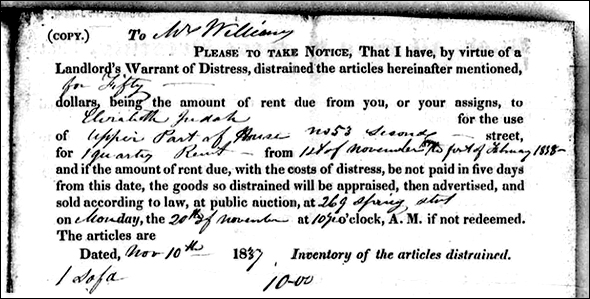A stressful situation for all
One sofa, valued at $10.00. Two carpets, another $10.00. A hearth rug, 50 cents. A table cloth and a looking glass, $3.00 each. A bureau, $8.00. Six chairs, $6.00. A small table, $2.50. A small glass, 50 cents. Blinds, $2.00. A rocking chair, $1.50.
That’s what somebody named Williams who lived at 53 Second Street, New York City, owned in November of 1837.
When that person — and those items — became the subject of a warrant of distress.
The Legal Genealogist just loves it when legal records are readily available online. And this record is just one in an updated collection at Ancestry called the New York, Selected Mayor’s Court Cases, 1674-1860.1 The collection itself, available courtesy of the American Jewish Historical Society, Center for Jewish History, New York City, is described as “images of select court case papers with Jewish sounding names on them (as selected by the American Jewish Historical Society). They were filed at the Mayor’s Court of New York City in civil lawsuits … (including) pleadings, affidavits, warrants, summons, briefs, etc., and are arranged in chronological order.”2
In this particular case, Elizabeth Judah had, “by virtue of a Landlord’s Warrant of Distress, distrained the articles” owned by the tenant Williams who lived in the “Upper Part of House no 53 Second Street” because of $50 rent for the quarter from the first of November 1837 to the first of February 1838 hadn’t been paid.3

So… what’s a warrant of distress? The warrant part is easy: it’s a “writ or precept from a competent authority in pursuance of law, directing the doing of an act, and addressed to an officer or person competent to do the act, and affording him protection from damage, if he does it.”4 The distress part? Well, that’s “taking a personal chattel out of the possession of a wrong-doer into the custody of the party injured, to procure a satisfaction for a wrong committed; as for non-payment of rent, or injury done by cattle.”5
And to distrain, then, was to “take as a pledge property of another, and keep the same until he performs his obligation … It was used to secure an appearance in court, payment of rent, performance of services, etc.,”6 while distraint simply meant “seizure.”7
On November 10th, the landlord notified the tenant and provided a list of the items distrained. That’s where we find out specifically what items were to be taken. And the notice told the tenant that if the rent wasn’t paid within five days the items would be appraised, then advertised and sold on November 20th to pay the rent.8
We know Elizabeth Judah had agents working for her — the documents were signed by B. Helbert Judah and Wash. N. Judah — and that she was shown in the 1837 New York City directory as the widow of Samuel.9
We know from the file that the items were appraised on November 15th, at a total value of $47.50.10 And that the landlord “Received Nov 20 1837 on acct of the within Claim Nineteen 93/100 Dollars.”11
Which sounds like the items did go up for sale and didn’t cover the rent due.
And which sure sounds like the Williams tenant — whoever he or she was12 — was out of luck, and out the door, by the 20th of November.
Just one of the stories you’ll find in court records every day.
And which is surely part of a family history for any descendant of the Williams tenant or the Judah landlord.
Even if it is, I’ll warrant, a bit distressing.
Cite/link to this post: Judy G. Russell, “Warranting distress,” The Legal Genealogist (https://www.legalgenealogist.com/blog : posted 17 Dec 2019).
SOURCES
- “New York, Selected Mayor’s Court Cases, 1674-1860,” database and images, Ancestry.com (https://www.ancestry.com : accessed 17 Dec 2019). ↩
- Ibid., “About New York, Selected Mayor’s Court Cases, 1674-1860.” ↩
- Warrant of Distress, Judah v. Williams, 6 Nov 1837, Mayor’s Court of New York City; “New York, Selected Mayor’s Court Cases, 1674-1860,” digital images, Ancestry.com (https://www.ancestry.com : accessed 17 Dec 2019). ↩
- Henry Campbell Black, A Dictionary of Law (St. Paul, Minn. : West, 1891), 1234, “warrant.” ↩
- Ibid., 378-379, “distress.” ↩
- Ibid., 378, “distrain.” ↩
- Ibid., “distraint.” ↩
- Notice of Warrant of Distress, Judah v. Williams, 10 Nov 1837, Mayor’s Court of New York City. ↩
- Classified Mercantile Directory for the Cities of New-York and Brooklyn (New York: J. Disturnell, 1837), 352, entry for “Judah, Elizabeth”; Fold3.com (https://www.fold3.com/ : accessed 17 Dec 2019). ↩
- Ibid., notation. ↩
- Ibid., page flap. ↩
- There’s no first name on any of the records and the salutation of Mr. or Mrs. isn’t consistently clear. ↩


